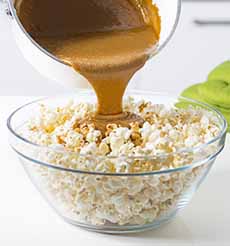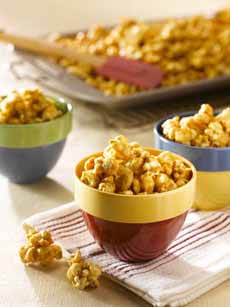Caramel Corn Recipes For National Caramel Corn Day
|
|
April 6th is National Caramel Corn Day. To make your own caramel, and pour it over your own warm popcorn, is so much more delicious than buying caramel corn. Try it! > There are more popcorn recipes below. > There’s also the history of caramel corn. > Why popcorn pops. 1. PLACE the popcorn in a large bowl. Remove any unpopped kernels. 2. SPRAY a large baking sheet with cooking spray; set aside. 3. ADD to a large, deep pot the brown sugar, butter, corn syrup and salt. Stir over medium heat until well blended. Increase the heat and bring to a boil. Allow to boil for 5 minutes. DO NOT STIR! 4. REMOVE the pan from the heat and stir in the baking soda (the mixture will foam*). Quickly stir popcorn into hot mixture until completely coated. 5. SPREAD onto the prepared baking sheet and allow to cool. Break into smaller pieces. Serve immediately or store in an airtight container. While Colonials enjoyed kettle corn (CHECK!), with both salt and sugar used to season the popcorn, caramel popcorn may be the creation of brothers Frederick and Louis Rueckheim, who immigrated to Chicago from Germany. In 1870, they opened a popcorn store and began to experiment with specialty flavors and toppings. One recipe, a mix of popcorn, peanuts and molasses, became a hit. The story is that a customer, upon sampling the flavor in the store, exclaimed “That’s a crackerjack!” The term meant, and still means, “exceptionally good.” The name stuck. An early version of Cracker Jack was introduced at the Chicago World’s Fair in 1893. Louis Rueckheim created a process that kept the molasses-covered popcorn kernels from sticking together [source]. In 1896, the brothers registered the trademark Cracker Jack®, and began to mass produce the product. The popularity of Cracker Jack led others to experiment with popcorn and syrups, which led to the creation of caramel corn [source] Today, commercial caramel popcorn is made by mixing a sugar solution or sometimes molasses (the Cracker Jack ingredient), and heating it until the mixture caramelizes. It then is blended with the popcorn. The recipe above is quite literal: homemade caramel—the real deal—is poured over the popcorn. *The baking soda is added to create tiny carbon dioxide air bubbles, which creates the foaming. Once the caramel has cooled on the popcorn, the air bubbles inside the caramel create a softer texture. |
|
|
CHECK OUT WHAT’S HAPPENING ON OUR HOME PAGE, THENIBBLE.COM. |
||








